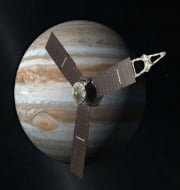NASA's Juno probe completes first Jupiter flyby
NASA’s solar-powered Juno spacecraft has successfully executed its first flyby of Jupiter, our solar system’s most massive planet.
During its first flyby, Juno passed just 4,200 kilometres above the planet’s clouds. It was the closest contact ever achieved by a man-made probe with Jupiter.
Key Facts
- During this flyby, it was for the first time Juno had its entire suite of science instruments activated.
- During this closest approach, Juno passed about 4,200 kilometres above Jupiter’s clouds and travelled at speed of 208,000 kilometres per hour with respect to the planet.
- There are 35 more close flybys of Jupiter planned during Juno’s mission scheduled to end in February 2018.
About Juno spacecraft
- The unmanned Juno spacecraft launched on August 5, 2011, from Florida, US. It had arrived at Jupiter on July 4, 2016.
- Juno is the first solar-powered mission designed by NASA to see beneath Jupiter’s clouds. It had travelled 2.7 billion kilometres since its launch to reach Jupiter.
- It has nine instruments on board to study atmosphere, gravity, magnetic field and possible existence of solid core in Jupiter.
- Juno will also map Jupiter’s gravity and magnetic fields and also track how much water is present in the atmosphere.
- It will have mission life of 20 months from July 2016 to Feb 2018. In its mission life, the spacecraft will circle the Jupiter 37 times before finally making a death plunge in 2018 in order to avoid accidentally crashing onto one of the planet’s moons.
Month: Current Affairs - August, 2016


